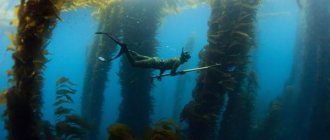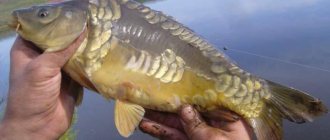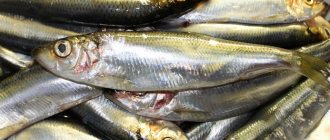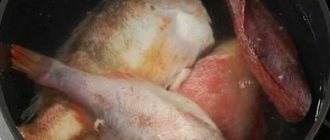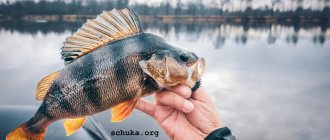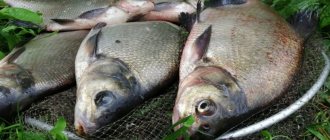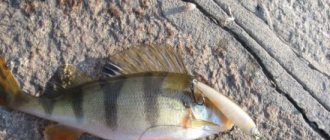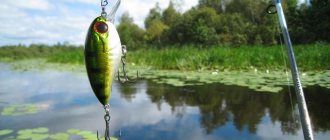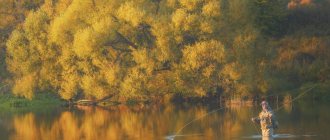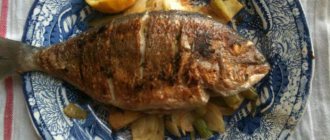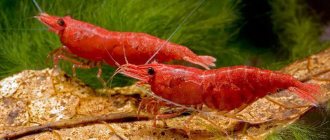Perch fish is the species of underwater inhabitants that most attracts the attention of fishermen due to its tasty, dietary meat, as well as the exciting fishing process. However, so that a lover of river hunting does not leave empty-handed, it is necessary to study information about the fish, find out the habits, descriptions, and characteristics of perches.
| Class | Ray-finned fish |
| Squad | Perciformes |
| Family | Perch |
| Genus | Freshwater groupers |
| View | More than 200 |
| Security status | Least Concern |
| The average size | 15-20 cm |
| Lifespan | 4-8 years |
| What does it eat? | Small fish |
| Optimal feeding time | Morning, afternoon, twilight |
| Enemies | Pike perch, catfish, pike, burbot |
| What do they bite on? | Maggot |
General description and characteristics with photos
The perch family has more than 200 species, but the most common is the common or river perch, which is divided into subspecies. Fish are found in freshwater or slightly salted waters. Perches are predators, although it would be more correct to call this species an omnivore, since the adult is insatiable and eats everything, including crayfish.
It is noteworthy that the characteristic features of fish change with the seasons:
- in the spring, until May, while spawning is in progress, perches live in shallow water, feeding on fish that swim to spawn;
- in summer, individuals prefer areas with slow currents, snags, and uneven river bottoms, suitable for hunting ambushes; in large bodies of water they prefer thickets of reeds or water lilies; in summer they look for shade - they hide under bridges or near piers;
- in autumn, perch follows its prey to deeper layers of the reservoir, where the temperature is higher;
- For wintering, the fish remain at depth, during this period their life processes slow down, predators practically do not move, only sometimes going on a hunt, which always goes well due to the fish wintering at the bottom.
When and where to catch perch
Unlike pike, you have to run after perch and need to look for it.
We recommend: Summer fishing tips and how to increase your catch
General rules:
- You can catch perch all day long, the main thing is to find where it is;
- The best biting time is early morning and late evening.
- It is practically not active at night, although in winter you can sometimes attract it with a flashlight, or by clearing the ice of snow, it can come up and start pecking perfectly even at night.
You should look in the following places:
- For perch, a high presence of oxygen in the water is important, so its main sites are areas with grass and algae, near the coastline overgrown with reeds and other vegetation, and places with dead wood.
- Perch are attracted to schools of local small fish.
- Large perch like to stay in the depths, especially in the cold season.
- Perches are schooling fish; large specimens usually live separately from the school.
- Perches prefer reservoirs and places with a sandy bottom, which is a kind of filter and absorbs little oxygen from the water, so such areas are always richer in oxygen. In such places there is a different food supply, which is easy to detect in the ground. Additionally, such light soil reflects sunlight well, which makes prey in the reservoir clearly visible.
Important to know: Perch do not form schools to hunt; they form schools only for protection. For this reason, if you find a school of perch and there is no bite, move on, most likely they are either full or do not want to hunt for other reasons.
The size of a school of perch often depends on the depth and availability of shelter in the water, usually in shallow reservoirs and coastal zones with a lack of vegetation, schools of larger perch. The formation of the pack is usually like this:
- small fish are outside;
- large specimens in the middle of the flock.
It is convenient to use an echo sounder for searching.
What does a common perch look like: external structure and body shape
Individuals of this species are distinguished by a streamlined, short, narrow, but tall body shape, which is explained by the specific nature of hunting - a sharp throw at the prey. The head of the perch is pointed with a voluminous mouth and lips, where there are large sharp teeth arranged in several rows, sometimes with fangs. There are large round eyes on the sides of the head, and olfactory openings at the top.
There are two fins (sometimes fused) on the back. The front fin is sharp, with 16 hard spines, the rear fin is with 12-17 softer spines. The anal fin is distinguished by the presence of 1-3 hard spines, the caudal fin has a notch. Pelvic fins are red or pink.
Coloring on the ventral and dorsal side
Coloration comes from habitat and subspecies. Sea inhabitants are distinguished by red and pink body tones, less often blue and yellow. Freshwater representatives have more muted scale colors. The dorsal part is much darker than the ventral part, which allows perches to camouflage themselves during hunting and from their enemies.
In general, freshwater specimens are greenish-yellow or gray-green in color with characteristic vertical black stripes on the sides. The muddier the bottom, the darker the color of the scales. The dorsal fins are gray-green in color, and the pectoral fins are yellowish. It is noteworthy that the belly feathers of representatives of different species are the same - reddish-pink.
Black dots on the body - what are they?
Many fishermen have more than once noticed black dots on their prey, located throughout the body of the fish, regardless of the species. This disease is called postodiplostomosis, the causative agents of which are worms and the carriers are birds.
The parasitic organism, measuring a maximum of 1.5 mm, lives in the intestines of the bird, after which it empties and enters the water. The next stage of development of the worm is the mollusk organism, where evolving asexual reproduction occurs, as a result of which a new type of parasite, the cercariae, appears from the deposited larva.
Penetrating inside the fish, the digenetic fluke firmly eats into the muscle, which causes black spots on the body. Cercariae are harmless to humans, but experienced fishermen still advise frying or boiling the infected catch more thoroughly.
Perch: description
This fish belongs to the perch family (Percidae) of the order Perciformes. The breed is numerous and quite widespread. There are a total of about 150 species. But in our reservoirs there are only 2.
Sometimes the perch is called the humpback, due to its slightly convex back. Small coastal perches eat insect larvae and zooplankton. A deep black-backed predator, it eats mainly small fish and its smaller brothers.
Appearance
Perch has a beautiful greenish color of various shades. With transverse dark stripes throughout the body. The body is short, laterally flattened, covered with small ctenoid scales. Small perches are lighter in color, while mature predators are darker.
The color is influenced by the color of the bottom of the reservoir, water quality, and time of year. Its gill covers are iridescent, with a unique pearlescent iridescence. The fins are all red and elegant. On the humpbacked back the fins are higher, with spiny, spiked rays.
The eyes are slightly convex, orange, surrounded on all sides by a golden border. The teeth are bristle-like, helping to eat and hold prey. Freshwater perches are usually small in size, no more than 250 grams, about 45-55 cm long. They live on average up to 10-12 years.
Habitat
- They live in many bodies of water in their range: ponds, reservoirs, lakes, alpine lakes, rivers.
- They are found in coastal areas of the seas and brackish lakes.
- The maximum habitat depth is 30-50 meters, but there is evidence that it is also found in deeper water places.
- They spend most of their lives closer to the bottom, near various obstacles, such as flooded trees and snags.
Spawning
Spawning occurs once a year. This time falls in March-April. Keep an eye on the birch trees; when their leaves bloom, it means spawning has begun. By this time, the water in the reservoirs has time to warm up to 7-8° C.
The female lays fertilized eggs on various nearby vegetation such as reeds, duckweed, and algae. Externally, caviar looks like gelatinous ribbons, reaching up to 1 meter.
Perch behavior
The behavior of a predator can change significantly throughout the day, much depends on the weather and time of year. In the spring, after spawning, it most often prefers to be in shallow bays, where it recently spawned and eats there. Schools of white fish also come into such bays to spawn.
And this is the ideal time for our perch to profit and recover a little after a hungry winter and spawning. And only in May it gathers in small flocks and leaves the shallow waters. In the summer, it prefers to set up ambushes in quiet creeks, overgrown with dense coastal vegetation, in barrels, and water lilies.
How to catch more fish?
But their most favorite places are the snagged bottoms of rivers and areas of the relief bottom adjacent to the riffles. In the summer heat, it eats less often and takes refuge more in coastal shady zones: bridge spans and supports, cliffs, shade of trees.
Large specimens hide in places hard to reach for people:
- pits, whirlpools;
- potholes with uneven bottom relief.
Perch usually comes out to feed in the evening after dark or at dawn. In large bodies of water it hides in stones, on elevated bottoms, in coastal thickets, on islands, and shallows. In the fall, it gathers in flocks and gradually moves into the depths of the reservoir.
Because in the deep layers the water is warmest. With the first frosts, activity increases; it does not stand in one place. Often schools of perches can be seen moving freely throughout the water area in search of food.
In winter, at shallow depths, a rapid process of decomposition of underwater plants occurs, significantly reducing the oxygen content in the water. All vital processes of aquatic life slow down significantly. The fish moves reluctantly and eats little.
Varieties
As already mentioned, there are more than 200 varieties of perch. Each has its own individual qualities.
River
The most common species has greenish-yellow scales. The head and mouth are large. The most common catch of fishermen. It lives in fresh water reservoirs, where it is introduced specifically for breeding.
Ozerny
It differs from the river one in a lighter or, conversely, darker color, and in greater weight, which reaches 5 kg.
Herbal
It is distinguished by its low weight - only 70. The body shape is more elongated. The predator lives in shallow water near algae.
Deep
It lives at a depth of more than 10 m in freshwater bodies. It is a coveted trophy among fishermen; they often go underwater fishing for this specimen.
The deep predator is divided into subspecies:
- coastal
found at a depth of 7-8 m. Externally different from the common perch with smaller eyes;
- deep
a real fisherman's dream. Individuals reach 50 cm and 4 kg. They live at a depth of more than 10 m. They differ from their relatives in their bluish color, powerful body, and strong teeth.
The growth rate of the underwater predator comes from the cleanliness of the reservoir - in unpolluted water the fish develops almost twice as fast. In addition, perch is vulnerable to temperature changes - at lower temperatures, activity decreases.
Yellow
Average length 33 cm, weight – 1.5 kg. Females of this species are larger than males. They live in freshwater bodies of water.
They differ from the common perch in having a more elongated, flattened body. The color of the back is dark green, the belly is white-yellow, the sides are golden-green with characteristic black stripes. The fins of the fish are reddish with gold edging. The saturation of shades depends on the habitat and purity of the water.
Perch firebrand
The official name is rotan. Externally similar to a bull. Color varies from gray-green to black with stripes or spots. The dark color usually appears during the mating season.
It lives in fresh waters, the quality of which is not important, since firebrands are very unpretentious. The length reaches 25 cm. The maximum lifespan is 7 years. The diet of rotan is leeches, small fish, larvae.
Balkhash
Maximum length – 50 cm, weight – 2 kg. Found in lakes. It is distinguished by silvery scales, an oblong shape, and an elongated lower jaw. It feeds on other fish and does not disdain its own brood in the absence of other food.
The meat of the Balkhash predator is considered the most delicious of the entire species.
Solar
A bright, beautiful representative of his species. It is distinguished by blue-gold scales and white and cream stripes, resembling rays, on the head. The color of males is more saturated than the color of females. The body is round, elongated with smooth features. There are small fins-ears near the head. Average length – 35 cm.
Found in fresh waters. Sun perches are often kept at home, placed in an aquarium for their attractive appearance.
Nautical
Despite the name, sea bass belongs to a different family and species. Its appearance and habits are strikingly different from its river counterpart, and its lifespan exceeds a hundred years.
The main difference is that its body has poisonous spines that do not harm humans, but are dangerous to other inhabitants of the underwater world. Saltwater perches typically measure up to 50 cm in size and have a maximum recorded weight of 10 kg.
Externally, the marine predator is distinguished by a large head, large eyes, and spines. The color is predominantly red with pinkish hues. The belly is light, the back is brown. The color varies slightly depending on the subspecies.
Nilsky
It is deservedly considered the fisherman’s most desired prey, because its weight reaches 200 kg and its length is 2 m. However, hunting for a giant is exhausting - often the fish pulls out the fishing rod and breaks the fishing line. Therefore, before fishing, you should gain experience, and also take a camera with you - a photo of the caught perch will become a pleasant memory.
The Nile perch is considered one of the largest freshwater predators that dominates inhabited water bodies. Externally, the huge predator is similar to a pike perch. The head is flattened, the eyes are large black and yellow. The shade of the scales is mainly silver or bluish, but there are individuals with a greenish-yellow color.
The diet includes crustaceans, small fish, and insects. Some experts claim that the Nile representative is not averse to eating drowned people, but does not specifically hunt for humans.
Types of perches
Fishes of the perch family are divided into species. At first glance, they are similar to each other. Only upon closer examination can one notice significant differences in the shape and color of the river inhabitants. There are three main types of perch:
- yellow;
- Balkhash;
- river.
Each species has its own characteristics and external characteristics, by which one can judge their habitat. It is curious that all fish have a common external characteristic - their needle-like fins and very small scales that fit tightly to the body.
- Yellow perch is a freshwater fish that is very similar in appearance to river fish. But unlike the second one, it is much smaller in size. At the same time, the mouth is much larger than that of a river fish, and the tail is not red, but yellow. In general, the anatomical similarity of the two species is quite significant. This factor allowed ichthyologists to produce completely viable offspring during hybridization.
- Balkhash perch also differs in appearance from river perch. First of all, it has more pronounced transverse stripes, and its body is longer and slightly elongated. This species can live in closed reservoirs, since they use their own fry for food.
- River perch, which lives in deep-sea waters, has relatively large eyes, which allow it to successfully hunt. The standard length of this species is 20−30 cm, but depending on the habitat, relatively large fish are found, reaching a length of 50 cm. Transverse dark stripes are clearly visible on the scales, and spiny red fins are located above and below.
On average, the weight of each species ranges from 300 grams to 3 kilograms. In the seas there are real giants, reaching 14 kilograms. Weight largely depends on what the perch eats.
Where does he live?
The habitat of perches depends on the subspecies. Freshwater animals are usually unpretentious to conditions; for them, the only thing that matters is the availability of food. Regardless of shallow or deep water, predators prefer the presence of vegetation, rocks, artificial or natural shelters on the bottom in order to be able to hunt or hide from other predators.
Most often, freshwater creatures choose stagnant water or rivers with a slow flow and uneven bottom.
Perches are found off the coast of America, Canada, Europe, Africa, Australia, New Zealand, and in southern and central Russia.
Description of the perch
It is impossible not to recognize the perch, because it has a number of characteristic features and a memorable appearance.
Appearance
This fish's body is laterally compressed. It is quite tall and covered with scales. Large individuals of river perch have a humped back and a large head.
The striped fish has sharp spines and spiny fin rays, the injections of which are extremely painful.
The color of the perch directly depends on the water in which they live. Thus, perches, common in clear water, are lighter in color than their counterparts, which live in forest lakes with dark-colored water. And individuals of perch living in reservoirs with very acidic water usually have a yellow-white color.
On the sides of this fish there are characteristic wide black stripes running across the body. Typically there are from five to nine such stripes.
The perch's eyes are orange, the fins are red, with the exception of the dorsal ones (they are less bright: gray and yellow-greenish).
As a rule, perch grows extremely slowly and very rarely can reach a maximum weight of four to five kilograms. Such specimens, as a rule, live on the bottom and are considered trophy.
Typically, fishermen distinguish the following subspecies of river perch:
How to catch more fish?
- shallow-water minke whale, which weighs up to 150 grams. He likes to hide in reed thickets; near the shore.
- humpback whale living in pools and deep holes in reservoirs. Among these “minke whales” you can find a trophy specimen.
Habitat
As mentioned above, this fish is very common. Freshwater perch can be found in various rivers, both small and large, as well as in standing and flowing reservoirs.
Perch lives in shallow water, in algae, reed thickets near the shore, in holes, channel edges, and also in places where bushes and trees lean over the water surface.
This schooling fish has a habit of moving long distances in a body of water when pursuing prey.
Spawning
As a rule, this fish reaches sexual maturity in the third year of life, when the length of their body reaches ten centimeters.
In different regions of our country, the spawning period of perch is different. So, in the southern regions it occurs at the end of winter, and in the regions of central Russia - in mid-spring. In the north, perch begins to spawn in May.
Features of behavior
Perch is voracious and can attack almost anything that comes its way.
This is a schooling fish that prefers to stay in shallow water and overgrown areas of reservoirs, or in whirlpools and deep pools where there are a lot of snags.
Perch is usually more active in the morning and evening and is highly mobile.
What does it eat?
Both sea and river perch are incredibly voracious. This fish is ready to feed without interruption; eternal hunger gives it energy and speed for the next extraction of food. There have been cases where fishermen caught perches with the remains of victims sticking out of their mouths, which simply did not fit into the stomach.
Perch is recognized as a predator, although in fact the fish is omnivorous. In addition to small fish up to 12 cm, caviar, crustaceans, mollusks, aquatic worms, plankton, insects, frogs, larvae, the insatiable perch eats algae and even pebbles, which help cleanse the intestines.
The main diet consists of minnows, roaches, rudd, sabrefish, crucian carp, bream, and other representatives of the carp family, but other fish, even closely related ones, are included in the edible interests of perches.
The main thing is that the prey swims in open areas without offering resistance. Also, cannibalism is often found among individuals of underwater gluttons; eternally hungry fish are not averse to tasting their own fry or caviar.
Perch is an active, predatory, schooling fish.
The Latin name of this fish is “Perca Fluviatilis” - translated as “river thorn”. Perch is one of the most common fish in the European part of Russia. And it is rightfully considered one of our most beautiful fish.
Perch is found everywhere: - in large and small lakes, reservoirs, large rivers and small rivulets, even in small ponds you can find this representative of the perch family!
The body of the perch is shortened and humpbacked. The larger the perch , the higher its body becomes, the hump becomes steeper. For this reason, large perches are called humpbacks. The back of the perch is dark green, the sides are yellowish-green, and the belly is yellowish. There are 5-9 transverse dark stripes on the sides of the body. The ventral, anal and caudal fins are red. The dorsal fin is equipped with spines. River perch is one of the most elegant fish!
The color of the perch is variable. In deep reservoirs with dark soil, perches are very dark, and in rivers with a light sandy bottom, perches are so light that the lateral transverse stripes are barely visible on the body. But the most beautiful perch are rightfully considered to be those living in deep peat lakes with black soil. The back of such perches is greenish-black, the lateral transverse stripes are clearly visible on the body. The sides are bright green. The abdomen is orange-yellow. The fins are bright red! Also, the color of the perch depends on the sex of the fish. Females are more elegant, the color of males is duller! During the day, the color of the perch changes. At night, the perches become lighter, and on a sunny day, the color becomes as bright as possible. The brightness of the colors of the fish also depends on the “mood” of the fish. So, when frightened or stressed, the color of the perch fades. In a school of perches, where there is a hierarchy, the largest perches have the most intense color, while smaller specimens are faded!
Recently, in fishermen's catches, perches with “freckles” have become increasingly common. In these fish, the entire body is dotted with black and brown spots. According to ichthyologists, this is a fish disease that is safe for humans, but whether this disease affects the fish themselves is unknown! Perches with “freckles” are just as active as their healthy counterparts: they chase prey, spawn and lead the usual lifestyle typical of all river perches!
The size of the average perch is not large! The usual weight is 100-200g. But there are also record holders who grow up to 1.5 kg and even 2 kg. Females are larger than males.
Perch is an active, predatory, schooling fish . It feeds exclusively on living moving organisms that are found in perch habitats. Juvenile fish, small crayfish during molting, amphipods, caddis flies, leeches, dragonfly larvae, bloodworms, water beetles, worms, any living organism that exhibits movement can become an object of hunting for perch. But the favorite prey of large perch is juvenile carp fish. Preference is given to narrow-bodied fish, such as bleak, verkhovka, sprat, bystryanka, herring, river and lake minnows, gudgeons, spined lances, and juvenile roach. Small young perches are content with easier and more accessible prey, eating defenseless aquatic insects. Very small perches feed on plankton alone for a long time.
Perch is a schooling fish ! Schools of perch can be huge, or they can consist of only 5-6 pieces. Compared to other fish, perch can be called an intellectual! What kind of hunting methods do perches use to catch nimble fry? In wide expanses of water with great depth, for example in reservoirs, large schools of perch are constantly in search of schools of small fish, because bleak, verkhovka, bystryanka, sprat. Having found a school of small fish, perches drive the small fry to the surface, take them into a tight ring and no longer release their victims beyond the perimeter of the ring. Such accumulations of juvenile fish and perch are called boilers. The perch cauldron can be seen from afar, by the concentration of seagulls. Having collected the fry in one place, the perches begin the feast! Perches quickly attack fish that are closer to the border of the boiler. This collective hunt continues until the entire school of perch is satiated.
In river bays, schools of perch prefer to drive fry into shallow water, right to the shore. And when hunting, they act on the same principle: - they attack fish that are trying to snatch them out of their environment to the depths.
Often, large schools of perch guard fish fry at the mouths of small rivers and streams.
Perches are schooling fish . But the larger the perches grow, the more they gravitate towards an independent life, separate from the school! The largest perches are solitary, independent predators. This is due to the fact that large perch no longer needs collective hunting and can independently hunt for any fish available in size. Also, fish are grouped into schools based on the principle of similar sizes, and small perches begin to shy away from their larger counterparts. When suitable conditions develop in a reservoir and many perches grow to large sizes, they willingly group into schools, and then such a school becomes a real thunderstorm in the reservoir.
Perch is a very tenacious, strong and strong fish! Perches can adapt to any living conditions and sometimes become a real scourge of a reservoir, eating large quantities of valuable fish species. Perches have few enemies! More or less regularly, only pike hunt small perch! And even that one, large perches are too tough for them. But the perch itself, in reservoirs where pike live, actively hunts for young squinting fish, thereby destroying its potential danger! Perches are no strangers to cannibalism. Large perches eat their own young in large quantities. At the stage of larvae and fry - fingerlings, perches are absolutely defenseless and become easy prey for many predatory fish.
Although perch is a sedentary fish and prefers to stick to familiar places in the reservoir, it is not alien to seasonal migrations. In the absence of food objects in their permanent habitat, the perch begins to move in search of places abounding in small fish and other food. Also, the habitat zones of perches are distributed according to size. Small perches stick to shallow bays, next to grass, debris from branches and snags, large perches go out into space and depth!
Perch spawns from late April to mid-May, at a water temperature of 6-15*C. Perch gathers for spawning in large schools, but the spawning itself takes place quietly and unnoticed! Large perch lay their eggs at depth, among thickets of branches. Small perches spawn in smaller places; they lay their eggs on last year’s hard vegetation and branches of trees fallen into the water. Since spawning occurs in fairly deep-water places, which remain under water even during periods of low water, spring fluctuations in water levels caused by the operation of hydroelectric power stations do not in any way affect the number of hatched eggs. This partly leads to the fact that perches in many reservoirs become, along with roach, the most abundant fish!
Spawning in perch is “nesting” - it involves one female and several males. The caviar is bottom, sticky, large. Females deposit it in long mucous ribbons.
At a water temperature of 10-12*C, its development lasts about 3 weeks.
After some time, the spawned, emaciated perches begin to actively feed and delight amateur anglers with intense bites, and for sports anglers, perch is a working fish that wins competitions.
Perch can be caught with almost all amateur gear.
Underwater hunters show interest only in the largest perches, whose weight exceeds a kilogram.
Perch is considered a low-value commercial fish. Small perch, for fishermen, is a trash fish that only gets in the way when unraveling nets.
From a gastronomic point of view, perch is of great interest. Perch has very tasty meat . The larger the perch, the better taste it has! There are few bones in the perch's meat, but the spiny fins and hard, durable, small scales that cover the perch's body like armor make it an unattractive fish for housewives.
Fishermen go to great lengths to make the process of cleaning perches easier and simpler. Many fishermen consider perch exclusively as a fish suitable only for hot smoking along with its scales. In perch that has undergone heat treatment, the scales can be easily removed along with the skin!
The article is from here - https://www.aqualife-nn.ru/texts/articles/95/185
Features of reproduction
Puberty of perches begins 2-4 years after birth. The male matures earlier than the females. Reproduction occurs when the reservoir warms up to at least 7 degrees, otherwise the female will not be able to lay eggs.
During spawning, perches go to shallow waters where there are enough snags. At one time, the female makes several clutches, each of which is a mesh tape up to 100 cm long, which contains about 300 thousand eggs, but most of them are eaten by birds or parents. Perches breed once a year, so they try to protect their offspring.
Each of the laid eggs usually does not exceed 4 mm. After two to three weeks, larvae appear and feed on plankton or invertebrates. After another couple of weeks, the larvae turn into fry. When their length reaches 10 cm, the fish becomes a full-fledged predator.
Secrets of fishing
Fishing for perch is fun at any time of the year and does not require much effort. Best fishing tips:
- hours - from dawn to dusk;
- weather - cloudy with a light breeze is best; in warm, calm weather the fish hides in thickets of algae or reeds;
- bait - it is better to use turf with worms thrown in there, then the fish will accumulate near the bait in anticipation of food;
- tackle;
- float rod - suitable for both shore and boats; the hook is chosen sharp, thin;
- spinning – suitable for the second half of summer;
- bottom tackle - suitable for fishing in reservoirs with strong currents;
- feeder – thanks to sensitive rods it is suitable for small bites.
How does the moon and atmospheric pressure affect the perch bite?
As with most predatory fish, during the full moon, perches become more active, especially large specimens. Activity is observed for three days after the full moon, then returns to normal. This is probably due to the ebb and flow of the tides and the large amount of food available at this time.
Perch, unlike carp fish, has a closed bubble air chamber, because of this, when the weather changes, it cannot quickly change the depth in the reservoir, and it needs more oxygen in the water, so when the pressure begins to change, it will immediately begin to go deeper and look for places with lots of oxygen. At this time he usually does not feed.
We recommend: What you need to rig a float rod
Atmospheric air pressure affects the amount of oxygen in water; the lower it is, the less oxygen and vice versa.
At normal and increased atmospheric pressure, perches are more active and hunt better. At low pressure there will most likely not be a bite.
